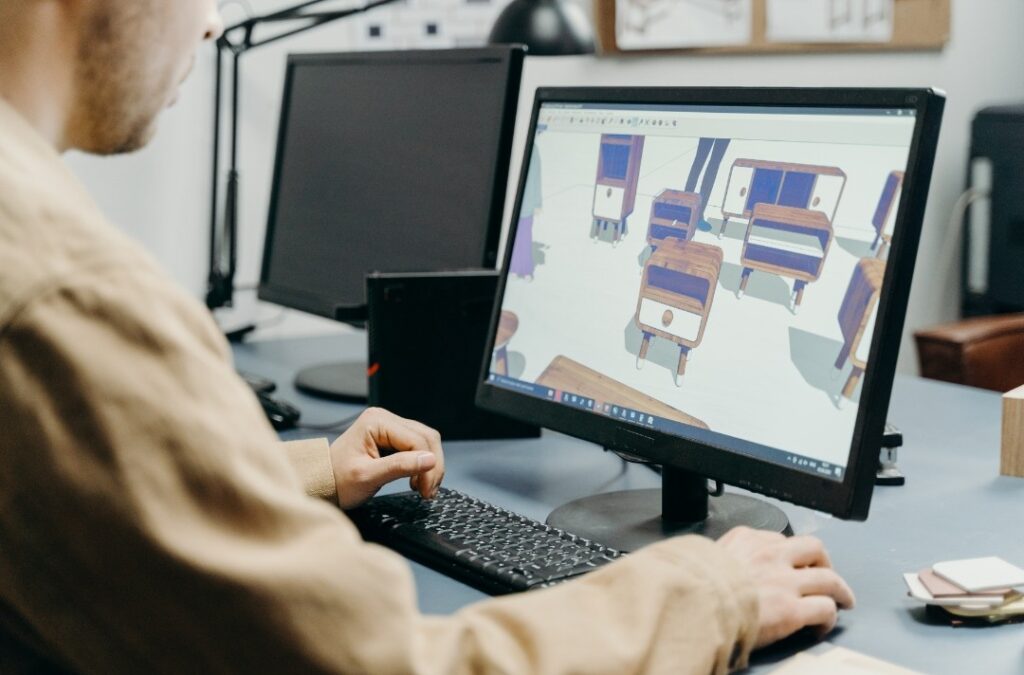In an era where technology and creativity intersect more than ever, CAD—short for Computer-Aided Design—has become a cornerstone in industries ranging from architecture and engineering to graphic design and manufacturing. Whether you’re designing the blueprint of a skyscraper, creating a mechanical component, or preparing a visual layout for packaging, Computer Aided Design plays a crucial role in how modern professionals bring ideas to life with precision and efficiency.
Despite its widespread use, many people are still unclear on what CAD really is, who uses it, and how it differs across disciplines. This article will guide you through the essentials of Computer Aided Design, how it’s used in various fields, and why it’s such a valuable skill in today’s competitive job market.
We’ll also examine the role of a draughtsman, explore CAD’s relevance in architecture and graphic design, and highlight the key tools and techniques used by professionals in this field.

What is CAD?
CAD, or Computer-Aided Design, is the use of computer software to aid in the creation, modification, analysis, or optimisation of a design. It replaces traditional manual drafting with a digital process that’s faster, more accurate, and easier to edit.
Using Computer Aided Design, designers can produce 2D drawings or 3D models that are used to visualise and simulate how a design will look and perform before it’s built or manufactured. This technology not only improves efficiency but also reduces human error and allows for advanced analysis, such as stress tests, load-bearing simulations, and material properties.
Key Features of Computer Aided Design
- Precision drawing and modelling
- 3D rendering and animation
- Layered design organisation
- Compatibility with CAM (Computer-Aided Manufacturing)
- File export options for printing or simulation
From skyscrapers to consumer electronics, Computer Aided Design is central to turning creative concepts into tangible results.
A Brief History of Computer Aided Design
The roots of CAD stretch back to the 1960s when engineers and scientists began experimenting with computers to assist in technical drawing. The earliest systems were limited, costly, and only accessible to large corporations. Over time, advances in computing power, affordability, and user interfaces brought Computer Aided Design to a much wider audience.
In the 1980s and 1990s, software like AutoCAD emerged as an industry standard, particularly for engineers and draughtsmen. Today, there are dozens of powerful Computer Aided Design tools, many of them specialised for particular industries, including architecture, mechanical engineering, and graphic design.
The Role of a Draughtsman in Computer Aided Design
A draughtsman (or draftsperson) is a skilled professional who creates technical drawings and plans using Computer Aided Design software. Traditionally, draughtsmen worked with pencils and drawing boards. Today, they rely on tools like AutoCAD, SolidWorks, and Revit to produce precise and detailed plans for buildings, machines, and systems.
Responsibilities of a CAD Draughtsman
- Producing 2D or 3D technical drawings
- Collaborating with engineers, architects, or designers
- Revising designs based on feedback or regulation changes
- Creating drawings to meet manufacturing or construction standards
- Applying Computer Aided Design standards and best practices
Computer Aided Design has revolutionised the role of the draughtsman, allowing for more complex designs, quicker revisions, and seamless collaboration across departments and industries.
How Computer Aided Design is Used in Architecture
One of the most widespread applications of Computer Aided Design is in architecture. Before construction begins, architects need to plan every detail—from structural layouts and electrical systems to interior aesthetics and material choices. Computer Aided Design software enables architects to visualise their designs in three dimensions, evaluate spatial relationships, and ensure compliance with building codes.
Advantages of Computer Aided Design in Architecture
- Accurate scaling and measurement
- Visualisation of interiors and exteriors in 3D
- Easy integration with engineering and HVAC plans
- Efficient project updates and revisions
- Better communication with clients and contractors
Common Computer Aided Design programs used in architecture include AutoCAD Architecture, Revit, SketchUp, and ArchiCAD. These platforms offer powerful features like Building Information Modeling (BIM), which integrates all aspects of building design into one coordinated model.
| Feature | Manual Drafting | CAD in Architecture |
|---|---|---|
| Editing | Time-consuming | Instant and precise |
| Accuracy | Prone to errors | High precision with snap tools |
| 3D Modelling | Not possible | Built-in tools |
| Collaboration | Manual document exchange | Cloud-based and shared files |
CAD in Graphic Design: A Creative Twist
While graphic design is typically associated with tools like Adobe Photoshop or Illustrator, Computer Aided Design plays a significant role in specialised areas such as packaging design, product visualisation, and industrial design. CAD enables graphic designers to work with precise dimensions, simulate physical materials, and create 3D mockups of their visual concepts.
For example, a packaging designer might use Computer Aided Design software to create a die line for a custom box, ensuring it fits perfectly around the product. They can then overlay their graphic artwork and view how the package will appear when assembled.
Graphic Design Tasks Enhanced by Computer Aided Design
- Creating vector-based technical layouts
- Generating dielines and print-ready files
- Producing 3D mockups for presentations
- Designing signage and spatial graphics
- Collaborating with product designers and engineers
Fusion 360, Rhino, and AutoCAD are commonly used by graphic designers involved in product development, allowing them to bridge the gap between artistic creativity and manufacturing reality.
Types of Computer Aided Design Systems
Computer Aided Design software comes in many forms depending on the use case and industry. Here’s a quick breakdown:
| Type of CAD | Description | Used In |
|---|---|---|
| 2D CAD | Focuses on flat drawings and schematics | Architecture, Electrical Layouts |
| 3D CAD | Allows for volumetric design and rendering | Product Design, Engineering |
| Parametric CAD | Defines models based on parameters and constraints | Mechanical Engineering, Architecture |
| Direct/Explicit CAD | Offers more freeform and artistic modelling | Industrial Design, Graphic Design |
Popular CAD Software by Industry
| Software Name | Industry Focus | Key Features |
|---|---|---|
| AutoCAD | General-purpose, widely used | 2D & 3D tools, industry add-ons |
| SolidWorks | Mechanical, Product Design | Parametric modelling, simulation |
| Revit | Architecture and Construction | BIM, collaboration tools |
| SketchUp | Architecture, Interior Design | User-friendly 3D modelling, plug-in support |
| Fusion 360 | Product and Graphic Design | Cloud-based, modelling, rendering, and CAM |
| Rhino 3D | Industrial and Graphic Design | Freeform modelling, scripting, rendering |
Benefits of Using Computer Aided Design
Using Computer Aided Design in professional design workflows offers a number of powerful advantages over manual techniques:
- Speed and Efficiency – Designs that took days can now be completed in hours.
- Accuracy – CAD tools reduce human error and allow for precise calculations.
- Documentation – Automatic generation of bills of materials, annotations, and parts lists.
- Visualisation – Clients and stakeholders can see realistic 3D models.
- Simulation – Designs can be tested under virtual conditions before physical production.
- Collaboration – CAD files can be shared and edited in real-time across global teams.
Computer Aided Design Skills in the Job Market
Whether you’re entering the field of architecture, training to become a draughtsman, or working in graphic design, Computer Aided Design proficiency is a critical and highly marketable skill.
Roles That Require Computer Aided Design
- CAD Draughtsman
- Architectural Technologist
- Mechanical Design Engineer
- Civil Engineer
- Product Designer
- Industrial Designer
- Graphic Product Visualiser
- Interior Designer
Average UK Salaries (2025 Estimates)
| Role | Salary Range |
|---|---|
| CAD Draughtsman | £28,000 – £42,000 |
| Architectural Designer | £35,000 – £55,000 |
| Mechanical CAD Engineer | £40,000 – £60,000 |
| Graphic Design & CAD Specialist | £30,000 – £50,000 |
Learning Computer Aided Design: Courses and Certifications
If you’re interested in mastering Computer Aided Design, there are plenty of online and in-person courses designed to suit beginners through to advanced professionals.
Recommended Learning Platforms
- Autodesk Learning Hub
- Coursera (CAD and Engineering Design)
- LinkedIn Learning (AutoCAD, Revit, Fusion 360)
- Udemy (Affordable CAD tutorials)
Certifications Worth Pursuing
- Autodesk Certified Professional (AutoCAD, Revit)
- CSWA (Certified SolidWorks Associate)
- Rhino Specialist Certification
- Fusion 360 Certified User
These certifications validate your skills and are often requested by employers, particularly in technical or engineering roles.
Final Thoughts
Computer AidedDesign has revolutionised how we design, plan, and build the world around us. From towering skyscrapers and intricate machinery to visually stunning product packaging, Computer-Aided Design plays a vital role in translating ideas into functional and aesthetically pleasing realities.
Whether you’re an aspiring draughtsman, an architectural enthusiast, or a graphic design professional seeking to expand your toolkit, learning Computer Aided Design is an investment in your future. As industries continue to evolve and adopt more technology-driven processes, Computer Aided Design expertise is becoming not just valuable—but essential.
Whether you’re sketching blueprints for the next great architectural wonder or creating custom product layouts, Computer Aided Design empowers you to bring creativity and precision together like never before.
